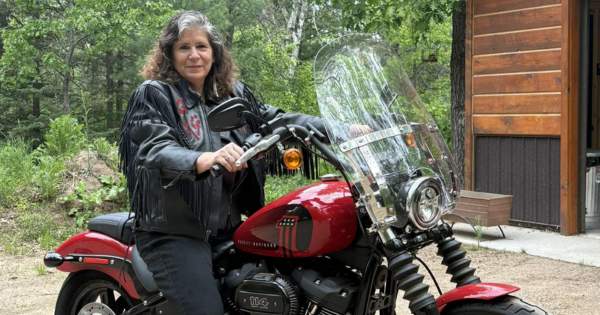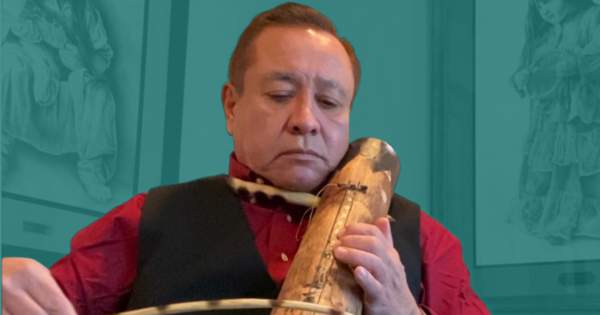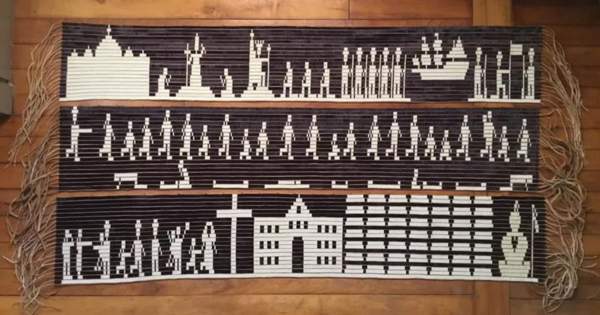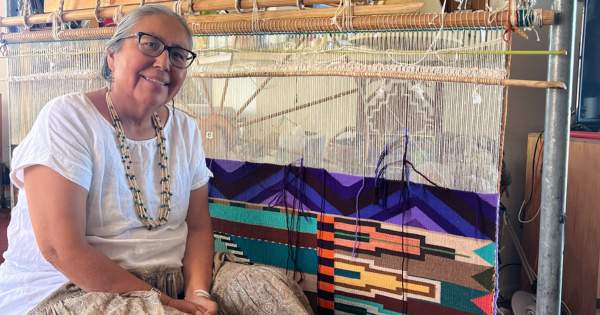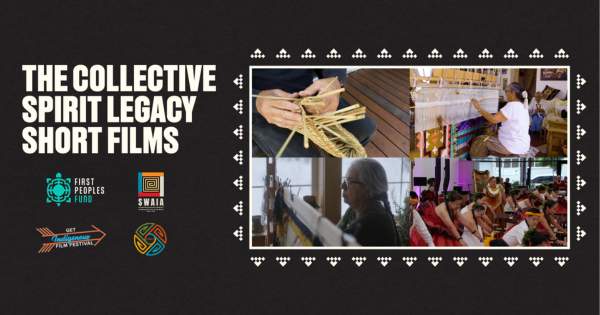
Intercultural Leadership Institute Fellows Drawn Into Lakota Culture Through Art And Place
By Sarah Elisabeth Sawyer (Choctaw Nation), Artist in Business Leadership Fellow 2015
Boxes and drawers in The Heritage Center collection at Red Cloud Indian School allowed Gwylene Gallimard of Charleston, South Carolina, to travel through Lakota culture. The collection includes nearly 10,000 pieces of Native American art. As Gwylene stood in the midst of the large storage facility, she felt as though she was in the past with the people who created the works. Gwylene appreciated the art in The Heritage Center gallery, yet it was the archives that drew her fully into Lakota Territory.
“Some of the pieces were very old and some were more recent,” Gwylene says, “but they were all considered important for the culture of Lakota people.”
A 1st generation French immigrant and co-leader in the “conNECKtedTOO” project, Gwylene is one of 29 fellows in the 2018 - 2019 Intercultural Leadership Institute (ILI) cohort who visited Lakota Territory. ILI is a year-long intensive leadership program for artists, culture bearers and other arts professionals. A collaborative program of Alternate ROOTS, First Peoples Fund, National Association of Latino Arts & Cultures (NALAC) and PA’I Foundation, ILI seeks to challenge dominant social norms while honoring differences of histories, traditions, vocabulary and more.
The cohort traveled to the ILI Lakota Territory convening — hosted by First Peoples Fund — September 12 - 16, 2018, for an immersive experience. Their journey began with grounding in the place through ceremony at Pe’ Sla, one of the sacred sites for Lakota people.
“When I was there in Lakota country, it was a much more diverse crowd than I’ve been in for a long time,” Gwylene says.
Visiting the collections and gallery at The Heritage Center gave the ILI cohort a chance to experience efforts to preserve and perpetuate Lakota history and culture. The gallery allowed them to see artists today who are working toward the same experience.
Joe Tolbert, a current ILI fellow from Knoxville, Tennessee, discovered the world of Native art for the first time.
“I felt like this whole world and tradition of art emerged out of nowhere,” Joe says. “I wondered why I didn’t know these artists existed, because their work is amazing. Had I not been on this trip, I probably never would have gone to the Red Cloud Heritage Center. I never would have seen these artists.”
Joe is the founder and lead cultural strategist for Art at the Intersections, a scholar, and Cultural Organizer. Coming to Lakota Territory for the first time laid foundational thought for interculturality, deepening his commitment to the goals of ILI to build stronger strategic intercultural collaborations, and promote traditional and contemporary practices of artists and culture bearers.
“After spending time with elders and cohort, and really taking in the learning that First Peoples Fund allowed me to experience, I came away being committed to helping people understand the Native American perspective,” Joe says. “I feel more committed to doing the hard things and getting through the hard things, to being able to share and educate in every way I can.”
Coming together to support transformative practices of artists and culture bearers allows these ILI fellows to align with one another and create a unique network of professionals with shared values. They are poised to fill in gaps that exists along cultural lines.
While lodging at High Country Guest Ranch, fellows and staff were treated by The Sioux Chef, Sean Sherman (Oglala Lakota), a 2015 FPF Artist in Business Leadership fellow. ILI fellows enjoyed an exquisite meal and Sean’s accompanying presentation on Indigenous foods and his efforts to revitalize traditional foodways.
“I have followed Sean Sherman’s career closely,” says ILI fellow Tara Moses (Seminole Nation of Oklahoma). “Not only being able to experience the food and lecture, but also having a one-on-one conversation with Sean was great because he and his team were always open and available.”
The intimacy throughout the convening was unique for Tara, an experience unlike she’s had with other fellowships and programs. She is a director, playwright, and Artistic Director of Binge Theatre Company, the world’s first online theatre company. Tara decided to apply for ILI after spotting the opportunity posted on Twitter.
“It was the first and only intercultural fellowship of its kind that I’ve ever seen, so that was a big enticer, especially since one of the founding partners is a Native organization,” Tara says. “It’s also cross-disciplinary in the arts which is something I do as a community organizer and artistic director. It felt as though it was an individually-designed fellowship just for me.”
“I felt like this whole world and tradition of art emerged out of nowhere,” Joe says. “I wondered why I didn’t know these artists existed, because their work is amazing. Had I not been on this trip, I probably never would have gone to the Red Cloud Heritage Center. I never would have seen these artists.”
Joe is the founder and lead cultural strategist for Art at the Intersections, a scholar, and Cultural Organizer. Coming to Lakota Territory for the first time laid foundational thought for interculturality, deepening his commitment to the goals of ILI to build stronger strategic intercultural collaborations, and promote traditional and contemporary practices of artists and culture bearers.
“After spending time with elders and cohort, and really taking in the learning that First Peoples Fund allowed me to experience, I came away being committed to helping people understand the Native American perspective,” Joe says. “I feel more committed to doing the hard things and getting through the hard things, to being able to share and educate in every way I can.”
Coming together to support transformative practices of artists and culture bearers allows these ILI fellows to align with one another and create a unique network of professionals with shared values. They are poised to fill in gaps that exists along cultural lines.
While lodging at High Country Guest Ranch, fellows and staff were treated by The Sioux Chef, Sean Sherman (Oglala Lakota), a 2015 FPF Artist in Business Leadership fellow. ILI fellows enjoyed an exquisite meal and Sean’s accompanying presentation on Indigenous foods and his efforts to revitalize traditional foodways.
“It was the first and only intercultural fellowship of its kind that I’ve ever seen, so that was a big enticer, especially since one of the founding partners is a Native organization. It’s also cross-disciplinary in the arts which is something I do as a community organizer and artistic director. It felt as though it was an individually-designed fellowship just for me.”
On the Pine Ridge Indian Reservation, fellows walked through past experiences of Lakota history at the Red Cloud Heritage Center gallery, collection, and campus before traveling to the top of a hill situated in the midst of the vast prairie land. The Wounded Knee cemetery, surrounded by a chain link fence and entered with ceremony, moved fellows emotionally with shared understanding of a history they had never encountered before.
“It helped me in realizing how the role of the artist and the culture bearer is to right the wrong history that’s been perpetuated. Thinking about my role as a person who uses arts and culture, how am I using that to correct the narrative?”
— Joe Tolbert, ILI Fellow
“It helped me in realizing how the role of the artist and the culture bearer is to right the wrong history that’s been perpetuated,” Joe says. “Thinking about my role as a person who uses arts and culture, how am I using that to correct the narrative?”
Collaborations are already sprouting from the new ILI cohort. Tara is working with ILI fellow Marshall Trammell on a benefit concert for awareness of missing and murdered Indigenous women.
“The point of the fellowship is being fully immersed in another culture and figuring out how that connects to our individual identities and our practices,” Tara says. “I look forward to being fully immersed in the other cultures and seeing how that intersects with my personal beliefs and practices, how it doesn’t, how I can learn from it, how I can grow, how it challenges me. I’m really excited about that.”

